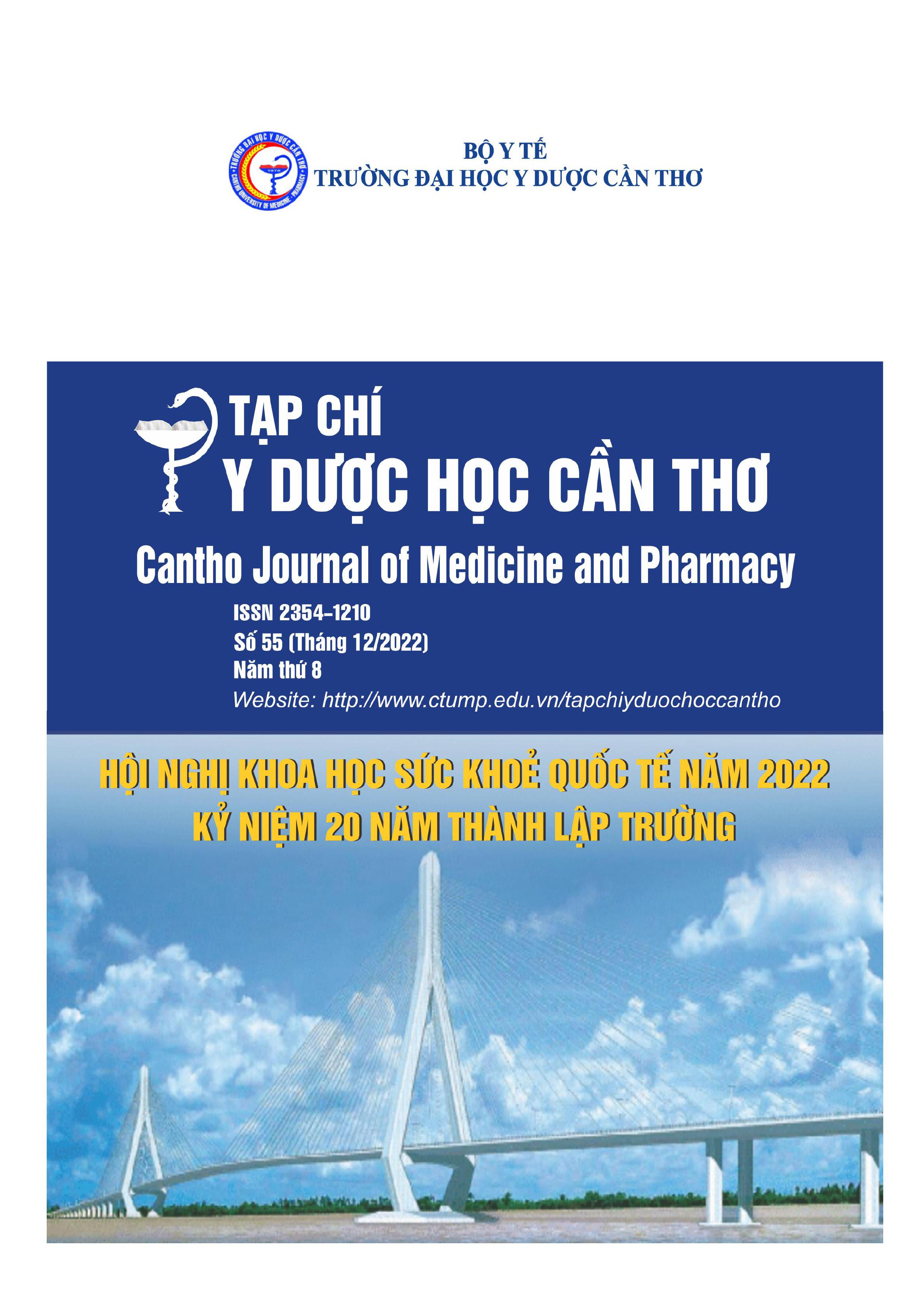PROGNOSTIC VALUE OF CHA2DS2-VASC SCORE FOR ADVERSE CARDIOVASCULAR EVENTS IN PATIENTS WITH ACUTE CORONARY SYNDROME UNDERGOING PERCUTANEOUS CORONARY INTERVENTION AT CAN THO CENTRAL GENERAL HOSPITAL
Main Article Content
Abstract
Background: The CHA2DS2-VASc score has mainly been used to predict the risk of embolic stroke in patients with nonvalvular atrial fibrillation. There has been a lot of research in the world which proved that the CHA2DS2-VASc scoring system could be used for risk stratification in patients with acute coronary syndrome. Objective: To investigate the rate of major adverse cardiovascular events and the value of the CHA2DS2-VASc score in predicting cardiovascular events in patients with acute coronary syndrome undergoing percutaneous coronary intervention. Materials and methods: Patients were diagnosed with acute coronary syndrome undergoing coronary angiography and percutaneous coronary intervention at Can Tho Central General Hospital. The method was a cross- sectional study with analysis. Results: During 6 months of follow-up after percutaneous coronary intervention, major adverse cardiovascular events occurred in 8.3% of patients. The area under the ROC curve for the CHA2DS2-VASc score in predicting major adverse cardiovascular events was 0.825 (p=0.001). A cut-off value of ≥4 had a sensitivity of 70% and a specificity of 80.9%. A Kaplan-Meier analysis of CHA2DS2-VASc scores of ≥4 showed a higher rate of adverse events as compared with scores of <4 (log-rank test, p<0.001). Conclusion: The CHA2DS2-VASc score is useful for the prediction of cardiovascular events in acute coronary syndrome patients undergoing percutaneous coronary intervention.
Article Details
Keywords
Acute coronary syndrome, cardiovascular events, CHA2DS2-VASc
References
2. Bùi Long (2018), Nghiên cứu kết quả điều trị can thiệp bệnh nhân hội chứng động mạch vành cấp bằng stent phủ thuốc có polymer tự tiêu, Luận án Tiến sỹ Y học, Học viện Quân y, Hà Nội.
3. Alcock RF, et al. (2013), Acute coronary syndrome and stable coronary artery disease: Are they so different? Long-term outcomes in a contemporary PCI cohort. International Journal of Cardiology, 167(4), pp.1343-1346.
4. Bozbay M, et al. (2017), CHA2DS2-VASc Score Predicts In-Hospital and Long-Term Clinical Outcomes in Patients With ST-Segment Elevation Myocardial Infarction Who Were Undergoing Primary Percutaneous Coronary Intervention. Clinical and Applied Thrombosis/Hemostasis, 23(2), pp.132-138.
5. Cannon Christopher P., et al. (2001), American College of Cardiology key data elements and definitions for measuring the clinical management and outcomes of patients with acute coronary syndromes: A report of the American College of Cardiology Task Force on Clinical Data Standards (Acute Coronary Syndromes Writing Committee). Journal of the American College of Cardiology, 38(7), pp.2114-2130.
6. Chua SK, et al. (2014), Use of CHADS₂ and CHA₂DS₂-VASc scores to predict subsequent myocardial infarction, stroke, and death in patients with acute coronary syndrome: data from Taiwan acute coronary syndrome full spectrum registry. PLoS One, 9(10), E111167.
7. Ibanez Borja, et al. (2017), 2017 ESC Guidelines for the management of acute myocardial infarction in patients presenting with ST-segment elevation: The Task Force for the management of acute myocardial infarction in patients presenting with ST-segment elevation of the European Society of Cardiology (ESC). European Heart Journal, 39(2), pp.119-177.
8. January CT, et al. (2014), 2014 AHA/ACC/HRS guideline for the management of patients with atrial fibrillation: A report of the American College of Cardiology/American Heart Association Task Force on Practice Guidelines and the Heart Rhythm Society. J Am Coll Cardiol, 64(21), 1-76.
9. Ma Xiaoteng, et al. (2020), Prognostic value of CHADS2 and CHA2DS2-VASc scores for post- discharge outcomes in patients with acute coronary syndrome undergoing percutaneous coronary intervention. Medicine, 99(30), E21321.
10. Nguyen TT, Hoang MV (2018), Non-communicable diseases, food and nutrition in Vietnam from 1975 to 2015: The burden and national response. Asia Pac J Clin Nutr, 27(1), pp.19-28.
11. Roffi M, et al. (2016), 2015 ESC Guidelines for the management of acute coronary syndromes in patients presenting without persistent ST-segment elevation: Task Force for the Management of Acute Coronary Syndromes in Patients Presenting without Persistent ST-Segment Elevation of the European Society of Cardiology (ESC). Eur Heart J, 37(3), pp.267-315.
12. Roth GA, et al. (2018), Global, regional, and national age-sex-specific mortality for 282 causes of death in 195 countries and territories, 1980-2017: A systematic analysis for the Global Burden of Disease Study 2017. The Lancet, 392(10159), pp.1736-1788.
13. Scudiero Fernando, et al. (2018), Relationship between CHA2DS2-VASc score, coronary artery disease severity, residual platelet reactivity and long-term clinical outcomes in patients with acute coronary syndrome. International Journal of Cardiology, 262(0), pp.9-13.
14. Węgiel Michał, et al. (2018), CHA2DS2-VASc and R2-CHA2DS2-VASc scores predict in- hospital and post-discharge outcome in patients with myocardial infarction. Advances in Interventional Cardiology/Postępy w Kardiologii Interwencyjnej, 14(4), pp.391-398.
15. Yoshikawa S, et al. (2019), Long-Term Efficacy and Safety of Everolimus-Eluting Stent Implantation in Japanese Patients with Acute Coronary Syndrome: Five-Year Real-World Data from the Tokyo-MD PCI Study. Journal of Interventional Cardiology, 2019(0), e3146848.


